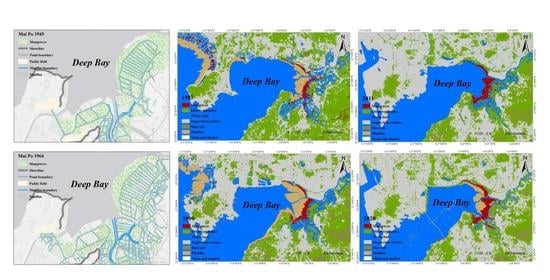Interpreting Mangrove Habitat and Coastal Land Cover Change in the Greater Bay Area, Southern China, from 1924 to 2020 Using Historical Aerial Photos and Multiple Sources of Satellite Data
Abstract
:1. Introduction
2. Study Area and Datasets
2.1. Study Area
2.2. Datasets
3. Methodology
3.1. Land Cover Mapping
3.1.1. Image Preprocessing
3.1.2. Spectral and Texture Feature Extraction
3.1.3. Classification of Mangrove Habitats and Other Land Cover Types
3.1.4. Accuracy Assessment
3.2. Post-Classification Analysis
Change Detection Analysis on Mangrove Habitats and Other Land Cover Types
4. Results
4.1. Accuracy Assessment
4.2. Mangrove Habitats and Other Land Cover Types Classification Results
4.3. Interrelationship between Mangrove Habitat and Urban Area Change
4.4. Land Cover Change Process: Natural and Anthropogenic Drivers
5. Discussion
6. Conclusions
Supplementary Materials
Author Contributions
Funding
Data Availability Statement
Conflicts of Interest
References
- Alongi, D.M. Present state and future of the world’s mangrove forests. Environ. Conserv. 2002, 29, 331–349. [Google Scholar] [CrossRef] [Green Version]
- Duke, N.C.; Ball, M.C.; Ellison, J.C. Factors influencing biodiversity and distributional gradients in mangroves. Glob. Ecol. Biogeogr. Lett. 1998, 7, 27–47. [Google Scholar] [CrossRef] [Green Version]
- Kathiresan, K.; Bingham, B.L. Biology of mangroves and mangrove ecosystems. Adv. Mar. Biol. 2001, 40, 81–251. [Google Scholar]
- Lee, S.Y.; Primavera, J.H.; Dahdouh-Guebas, F.; McKee, K.; Bosire, J.O.; Cannicci, S.; Diele, K.; Fromard, F.; Koedam, N.; Marchand, C.; et al. Ecological role and services of tropical mangrove ecosystems: A reassessment. Glob. Ecol. Biogeogr. 2014, 23, 726–743. [Google Scholar] [CrossRef]
- Duke, N.C.; Meynecke, J.O.; Dittmann, S.; Ellison, A.M.; Anger, K.; Berger, U.; Cannicci, S.; Diele, K.; Ewel, K.C.; Field, C.D.; et al. A world without mangroves? Science 2007, 317, 41–42. [Google Scholar] [CrossRef] [Green Version]
- Richards, D.R.; Friess, D.A. Rates and drivers of mangrove deforestation in Southeast Asia, 2000–2012. Proc. Natl. Acad. Sci. USA 2016, 113, 344–349. [Google Scholar] [CrossRef] [Green Version]
- Donato, D.C.; Kauffman, J.B.; Murdiyarso, D.; Kurnianto, S.; Stidham, M.; Kanninen, M. Mangroves among the most carbon-rich forests in the tropics. Nat. Geosci. 2011, 4, 293–297. [Google Scholar] [CrossRef]
- Dahdouh-Guebas, F.; Verheyden, A.; De Genst, W.; Hettiarachchi, S.; Koedam, N. Four decade vegetation dynamics in Sri Lankan mangroves as detected from sequential aerial photography: A case study in Galle. Bull. Mar. Sci. 2000, 67, 741–759. [Google Scholar]
- Lee, S.Y.; Khim, J.S. Hard science is essential to restoring soft-sediment intertidal habitats in burgeoning East Asia. Chemosphere 2017, 168, 765–776. [Google Scholar] [CrossRef]
- Massad, R.S.; Lathière, J.; Strada, S.; Perrin, M.; Personne, E.; Stéfanon, M.; Stella, P.; Szopa, S.; Noblet-Ducoudré, N.D. Reviews and syntheses: Influences of landscape structure and land uses on local to regional climate and air quality. Biogeosciences 2019, 16, 2369–2408. [Google Scholar] [CrossRef] [Green Version]
- Li, M.S.; Lee, S.Y. Carbon dynamics of Deep Bay, eastern Pearl River Estuary, China. I: A mass balance budget and implications for shorebird conservation. Mar. Ecol. Prog. Ser. 1998, 172, 73–87. [Google Scholar] [CrossRef] [Green Version]
- Hui, E.C.; Li, X.; Chen, T.; Lang, W. Deciphering the spatial structure of China’s megacity region: A new bay area—The Guangdong-Hong Kong-Macao Greater Bay Area in the making. Cities 2020, 105, 102168. [Google Scholar] [CrossRef]
- Tam, N.F.; Wong, Y.S.; Lu, C.Y.; Berry, R. Mapping and characterization of mangrove plant communities in Hong Kong. In Asia-Pacific Conference on Science and Management of Coastal Environment; Springer: Dordrecht, The Netherlands, 1997; pp. 25–37. [Google Scholar]
- Jia, M.; Liu, M.; Wang, Z.; Mao, D.; Ren, C.; Cui, H. Evaluating the effectiveness of conservation on mangroves: A remote sensing-based comparison for two adjacent protected areas in Shenzhen and Hong Kong, China. Remote Sens. 2016, 8, 627. [Google Scholar] [CrossRef] [Green Version]
- Haralick, R.M.; Shanmugam, K.; Dinstein, I.H. Textural features for image classification. IEEE Trans. Syst. Man Cybern. 1973, 6, 610–621. [Google Scholar] [CrossRef] [Green Version]
- Zhang, Y.; Zhang, H.; Lin, H. Improving the impervious surface estimation with combined use of optical and SAR remote sensing images. Remote Sens. Environ. 2014, 141, 155–167. [Google Scholar] [CrossRef]
- Puissant, A.; Hirsch, J.; Weber, C. The utility of texture analysis to improve per-pixel classification for high to very high spatial resolution imagery. Int. J. Remote Sens. 2005, 26, 733–745. [Google Scholar] [CrossRef]
- Gislason, P.O.; Benediktsson, J.A.; Sveinsson, J.R. Random forests for land cover classification. Pattern Recognit. Lett. 2006, 27, 294–300. [Google Scholar] [CrossRef]
- Guo, L.; Chehata, N.; Mallet, C.; Boukir, S. Relevance of airborne lidar and multispectral image data for urban scene classification using Random Forests. ISPRS J. Photogramm. Remote Sens. 2011, 66, 56–66. [Google Scholar] [CrossRef]
- Ham, J.; Chen, Y.; Crawford, M.M.; Ghosh, J. Investigation of the random forest framework for classification of hyperspectral data. IEEE Trans. Geosci. Remote Sens. 2005, 43, 492–501. [Google Scholar] [CrossRef] [Green Version]
- Cutler, D.R.; Edwards Jr, T.C.; Beard, K.H.; Cutler, A.; Hess, K.T.; Gibson, J.; Lawler, J.J. Random forests for classification in ecology. Ecology 2007, 88, 2783–2792. [Google Scholar] [CrossRef]
- Hu, L.; Li, W.; Xu, B. Monitoring mangrove forest change in China from 1990 to 2015 using Landsat-derived spectral-temporal variability metrics. Int. J. Appl. Earth Obs. Geoinf. 2018, 73, 88–98. [Google Scholar] [CrossRef]
- Ai, B.; Zhang, R.; Zhang, H.; Ma, C.; Gu, F. Dynamic process and artificial mechanism of coastline change in the Pearl River Estuary. Reg. Stud. Mar. Sci. 2019, 30, 100715. [Google Scholar] [CrossRef]
- Wang, H.; Peng, Y.; Wang, C.; Wen, Q.; Xu, J.; Hu, Z.; Jia, X.; Zhao, X.; Lian, W.; Temmerman, S.; et al. Mangrove loss and gain in a densely populated urban estuary: Lessons from the Guangdong-Hong Kong-Macao Greater Bay Area. Front. Mar. Sci. 2021, 8, 693450. [Google Scholar] [CrossRef]
- Liu, M.; Zhang, H.; Lin, G.; Lin, H.; Tang, D. Zonation and directional dynamics of mangrove forests derived from time-series satellite imagery in Mai Po, Hong Kong. Sustainability 2018, 10, 1913. [Google Scholar] [CrossRef] [Green Version]
- Wang, W.; Fu, H.; Lee, S.Y.; Fan, H.; Wang, M. Can strict protection stop the decline of mangrove ecosystems in China? From rapid destruction to rampant degradation. Forests 2020, 11, 55. [Google Scholar] [CrossRef] [Green Version]
- Yang, Y.; Chui, T.F.M. The role of the Pearl River flow in Deep Bay hydrodynamics and potential impacts of flow variation and land reclamation. J. Hydro-Environ. Res. 2021, 34, 1–10. [Google Scholar] [CrossRef]
- Yang, Y.; Chui, T.F.M. Hydrodynamic and transport responses to land reclamation in different areas of semi-enclosed subtropical bay. Cont. Shelf Res. 2017, 143, 54–66. [Google Scholar] [CrossRef]
- FAO. The World’s Mangroves 1980–2005; FAO Forestry Paper 153; Food and Agriculture Organization, United Nations: Rome, Italy, 2007. [Google Scholar]
- Lee, S.Y.; Hamilton, S.; Barbier, E.B.; Primavera, J.; Lewis, R.R. Better restoration policies are needed to conserve mangrove ecosystems. Nat. Ecol. Evol. 2019, 3, 870–872. [Google Scholar] [CrossRef]
- Adame, M.F.; Zakaria, R.M.; Fry, B.; Chong, V.C.; Then, A.H.A.; Brown, C.J.; Lee, S.Y. Loss and recovery of carbon and nitrogen after mangrove clearing. Ocean Coast. Manag. 2018, 161, 117–126. [Google Scholar] [CrossRef]
- He, Z.; Peng, Y.; Guan, D.; Hu, Z.; Chen, Y.; Lee, S.Y. Appearance can be deceptive: Shrubby native mangrove species contributes more to soil carbon sequestration than fast-growing exotic species. Plant Soil 2018, 432, 425–436. [Google Scholar] [CrossRef]
- Cai, L.Z. Zoobenthic Ecology in Shenzhen Bay; Xiamen University Press: Xiamen, China, 2015. [Google Scholar]

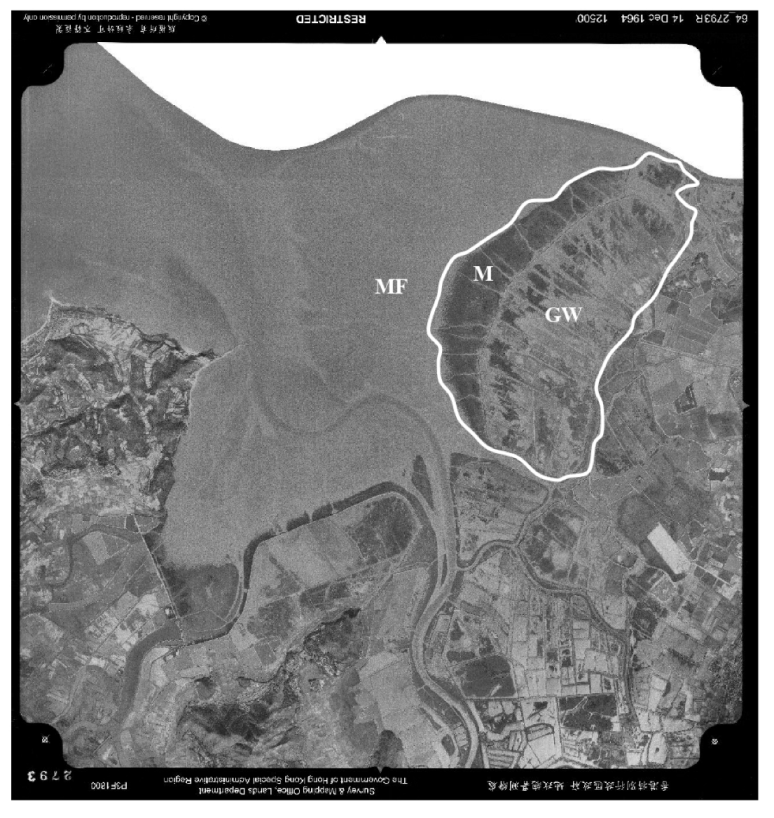
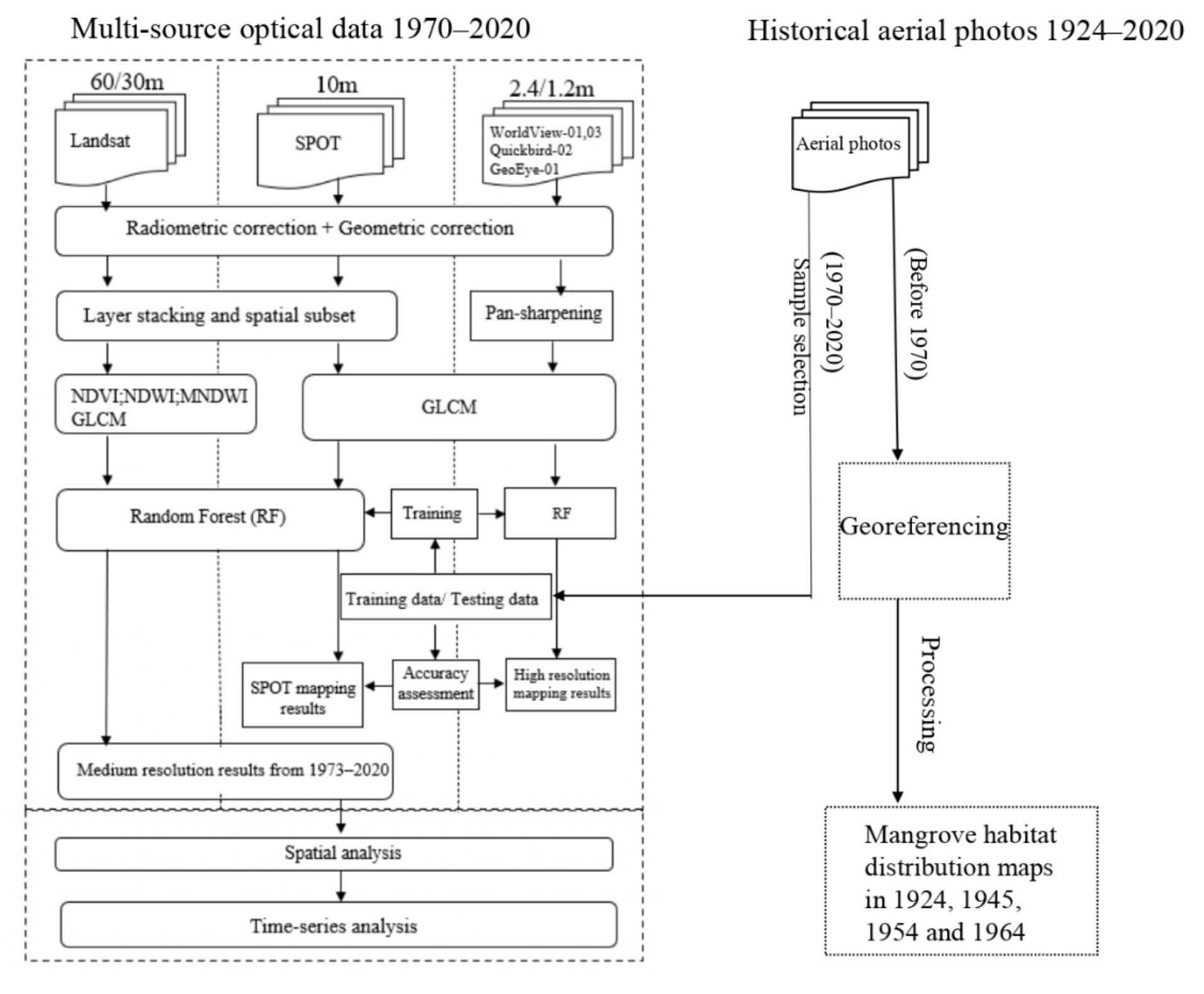
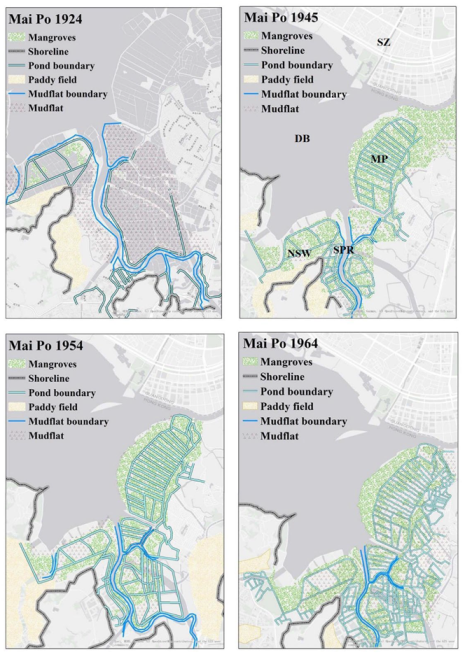




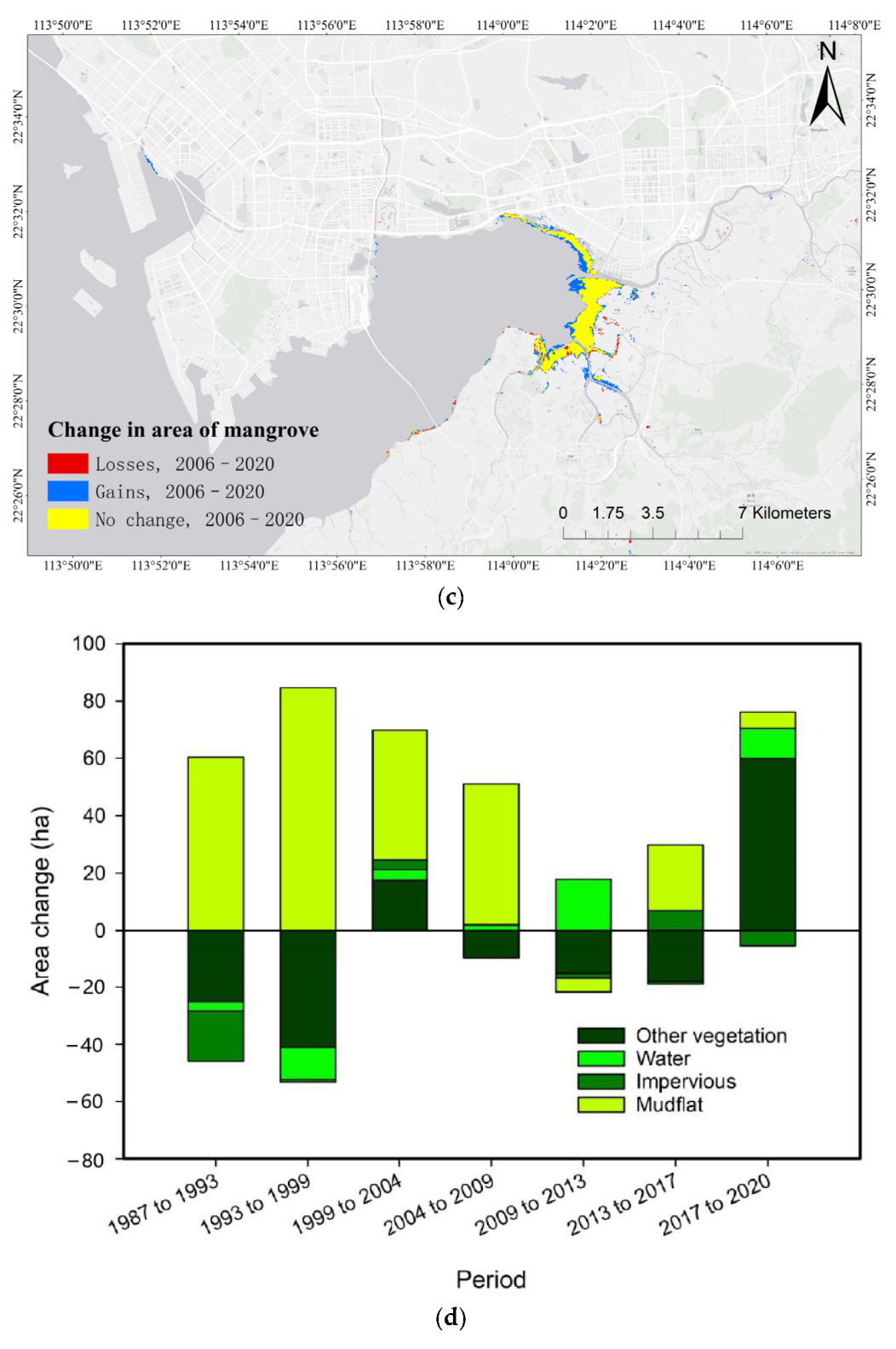


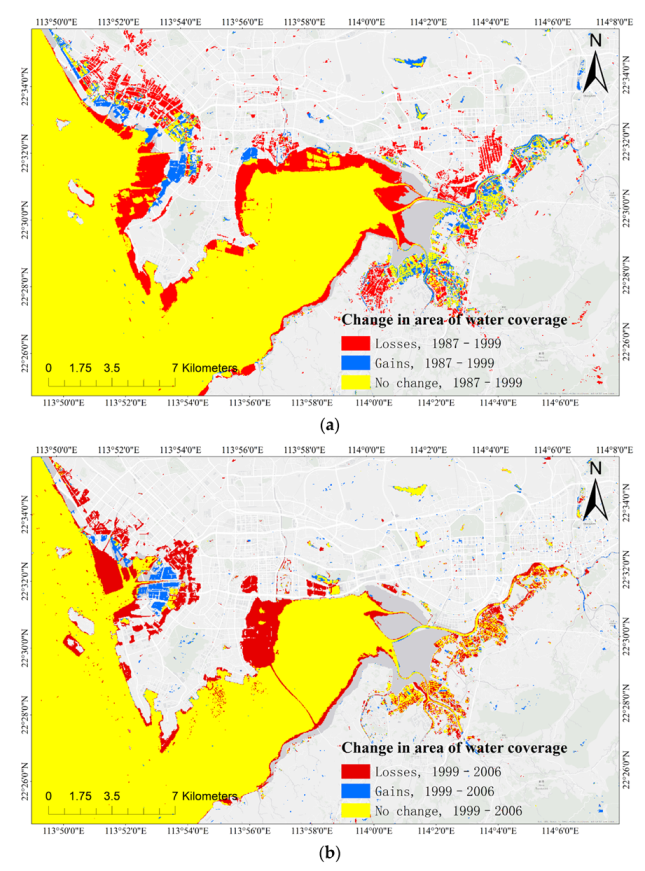

| Land Cover Type | Satellite Image |
|---|---|
| Mangrove habitat |  |
| Other vegetation |  |
| Water body |  |
| Bare land |  |
| Impervious surface |  |
| Mudflat |  |
| Shadow and mask |  |
| Year | Mangrove Habitat | Other Vegetation | Water Body | Bare Land | Impervious Surface | Mudflat | Shadow and Mask |
|---|---|---|---|---|---|---|---|
| 1987 | 64/1082 | 62/883 | 35/409 | 10/152 | 29/434 | 17/140 | 1/24 |
| 1988 | 75/1093 | 101/1182 | 25/226 | 18/246 | 48/1212 | 54/1152 | 2/130 |
| 1991 | 55/647 | 78/1829 | 32/807 | 31/201 | 65/498 | 41/447 | 2/46 |
| 1993 | 49/1246 | 50/1077 | 16/472 | 8/93 | 29/926 | 18/192 | 2/109 |
| 1995 | 65/765 | 54/1010 | 23/374 | 23/195 | 55/850 | 42/655 | 14/136 |
| 1997 | 46/949 | 49/1729 | 17/631 | 6/54 | 53/665 | 1/6 | 6/344 |
| 2000 | 97/4422 | 70/5330 | 20/1425 | 10/149 | 20/1408 | 10/631 | 1/71 |
| 2002 | 74/961 | 89/1607 | 26/706 | 24/256 | 58/1053 | 35/556 | 4/48 |
| 2004 | 123/4093 | 66/3275 | 32/1102 | 12/274 | 19/1396 | 33/522 | 5/219 |
| 2006 | 68/1013 | 59/1031 | 28/462 | 20/155 | 48/563 | 36/551 | 6/48 |
| 2008 | 84/3863 | 46/2302 | 16/769 | 4/168 | 15/1627 | 15/817 | 4/79 |
| 2011 | 149/6397 | 76/3729 | 20/818 | 14/223 | 23/1663 | 24/1381 | 1/107 |
| 2013 | 59/1147 | 28/1289 | 16/751 | 18/282 | 27/544 | 12/466 | 2/54 |
| 2015 | 66/1723 | 101/1647 | 53/827 | 13/61 | 75/967 | 22/410 | 2/41 |
| 2017 | 56/1024 | 56/1967 | 22/797 | 10/89 | 38/631 | 5/71 | 2/54 |
| 2019 | 56/1776 | 48/1205 | 21/552 | 18/173 | 58/859 | 11/155 | 12/80 |
| 2020 | 50/1407 | 59/1660 | 29/827 | 14/168 | 22/1012 | 18/486 | 7/154 |
| Date of Landsat Data | Sources of Reference Data |
|---|---|
| 1987 | Aerial photos in 1987. |
| 1988 | Aerial photos in 1988. |
| 1991 | Aerial photos in 1991; SPOT1 HRV data in 1991; high-resolution satellite data in 1991 from Google Earth. |
| 1993 | Aerial photos in 1993; SPOT1 HRV data in 1993. |
| 1995 | Aerial photos in 1995. |
| 1997 | Aerial photos in 1997; SPOT1 HRV data in 1997. |
| 1999 | Aerial photos in 1999; SPOT4 HRIVR data in 2000; high resolution satellite data in 2000 from Google Earth. |
| 2001 | Aerial photos in 2001; SPOT4 HRIVR data in 2000; high resolution satellite data in 2000 from Google Earth. |
| 2002 | Aerial photos in 2002; SPOT4 HRIVR data in 2002; QuickBird-02 data in 2003; high resolution satellite data in 2002 from Google Earth. |
| 2004 | Aerial photos in 2004; SPOT5 HRG data in 2004; QuickBird-02 data in 2003; high resolution satellite data in 2004 from Google Earth; AFCD data. |
| 2006 | Aerial photos in 2006; AFCD data. |
| 2009 | Aerial photos in 2009; SPOT5 HRG data in 2008; QuickBird-02 data in 2008; Worldview-02 data in 2010; high resolution satellite data in 2008 from Google Earth. |
| 2011 | Aerial photos in 2011; SPOT5 HRG data in 2010; Worldview-02 in 2010; high resolution satellite data in 2011 from Google Earth. |
| 2013 | Aerial photos in 2013; GE-01data in 2013; high resolution satellite data in 2013 from Google Earth; field validation data. |
| 2015 | Aerial photos in 2015; Worldview-03 data in 2015; high resolution satellite data in 2015 from Google Earth; field validation data. |
| 2017 | Aerial photos in 2017; Worldview-02 data in 2017; high resolution satellite data in 2017 from Google Earth; field validation data. |
| 2019 | Aerial photos in 2019; high resolution satellite data in 2019 from Google Earth. |
| 2020 | Aerial photos in 2020; high resolution satellite data in 2020 from Google Earth. |
| Year | Mangrove Habitats | Other Vegetation | Water Body | Impervious Surface | Bare Soil | Mudflat | Overall Accuracy | Kappa Coefficient | ||||||
|---|---|---|---|---|---|---|---|---|---|---|---|---|---|---|
| PA | UA | PA | UA | PA | UA | PA | UA | PA | UA | PA | UA | |||
| 1987 | 100% | 99.5% | 98.9% | 100% | 100% | 97.6% | 97.7% | 100% | 100% | 100% | 100% | 100% | 99.4% | 0.99 |
| 1988 | 99.1% | 100% | 100% | 99.2% | 100% | 100% | 100% | 100% | 100% | 100% | 100% | 100% | 99.8% | 0.99 |
| 1991 | 97.7% | 100% | 100% | 99.2% | 100% | 100% | 100% | 100% | 100% | 100% | 100% | 100% | 99.7% | 0.99 |
| 1993 | 99.6% | 100% | 100% | 99.5% | 100% | 98.9% | 99.5% | 100% | 100% | 100% | 100% | 100% | 99.7% | 0.99 |
| 1995 | 98.7% | 99.3% | 99.5% | 99.1% | 97.5% | 100% | 100% | 99.4% | 97.4% | 100% | 100% | 98.5% | 99.2% | 0.99 |
| 1997 | 97.9% | 100% | 100% | 98.9% | 100% | 100% | 100% | 100% | 100% | 100% | 100% | 100% | 99.5% | 0.99 |
| 1999 | 98.8% | 98.2% | 98.4% | 99.4% | 100% | 100% | 100% | 100% | 100% | 94.3% | 100% | 100% | 99.2% | 0.99 |
| 2001 | 98.8% | 100% | 100% | 99.7% | 100% | 100% | 100% | 99.5% | 98.0% | 100% | 100% | 98.8% | 99.7% | 0.99 |
| 2002 | 100% | 98.5% | 99.4% | 99.7% | 100% | 100% | 100% | 100% | 100% | 100% | 99.1% | 100% | 99.7% | 0.99 |
| 2004 | 99.5% | 99.0% | 99.0% | 98.6% | 100% | 100% | 100% | 100% | 94.6% | 100% | 100% | 100% | 99.3% | 0.99 |
| 2006 | 98.5% | 99.5% | 99.5% | 98.6% | 100% | 98.9% | 99.1% | 100% | 100% | 100% | 100% | 100% | 99.3% | 0.99 |
| 2009 | 96.6% | 97.8% | 98.3% | 96.6% | 100% | 100% | 100% | 99.1% | 89.2% | 100% | 100% | 100% | 97.9% | 0.97 |
| 2011 | 100% | 99.8% | 99.4% | 99.7% | 99.3% | 98.0% | 97.3% | 98.2% | 94.6% | 100% | 100% | 100% | 99.5% | 0.99 |
| 2013 | 100% | 100% | 100% | 100% | 100% | 100% | 100% | 99.1% | 98.2% | 100% | 100% | 100% | 99.8% | 0.99 |
| 2015 | 98.5% | 100% | 99.7% | 98.6% | 100% | 100% | 100% | 99.1% | 83.3% | 100% | 100% | 98.8% | 99.3% | 0.99 |
| 2017 | 98.0% | 99.0% | 99.5% | 99.3% | 100% | 100% | 100% | 99.3% | 100% | 100% | 100% | 100% | 99.4% | 0.99 |
| 2019 | 98.9% | 100% | 100% | 98.4% | 100% | 100% | 100% | 98.8% | 94.1% | 100% | 100% | 100% | 99.4% | 0.99 |
| 2020 | 99.3% | 99.6% | 99.7% | 99.4% | 100% | 100% | 100% | 99.5% | 97.0% | 100% | 100% | 100% | 99.6% | 0.99 |
| Year | Overall Accuracy | Kappa Coefficient | ||||||
|---|---|---|---|---|---|---|---|---|
| Minimum | Maximum | Mean | SD | Minimum | Maximum | Mean | SD | |
| 1987 | 99.68% | 100% | 99.84% | 0.113 | 0.996 | 1 | 0.998 | 0.001 |
| 1988 | 99.52% | 99.91% | 99.71% | 0.151 | 0.994 | 0.999 | 0.996 | 0.002 |
| 1991 | 99.55% | 100% | 99.73% | 0.187 | 0.994 | 1 | 0.996 | 0.002 |
| 1993 | 99.76% | 99.88% | 99.83% | 0.067 | 0.997 | 0.998 | 0.998 | 0.001 |
| 1995 | 99.26% | 99.75% | 99.55% | 0.225 | 0.991 | 0.997 | 0.995 | 0.003 |
| 1997 | 98.40% | 99.77% | 98.97% | 0.593 | 0.979 | 0.997 | 0.986 | 0.008 |
| 1999 | 98.83% | 99.79% | 99.28% | 0.348 | 0.985 | 0.997 | 0.991 | 0.004 |
| 2001 | 99.49% | 99.79% | 99.65% | 0.138 | 0.993 | 0.997 | 0.996 | 0.002 |
| 2002 | 99.04% | 99.90% | 99.54% | 0.356 | 0.988 | 0.999 | 0.994 | 0.004 |
| 2004 | 99.48% | 99.74% | 99.61% | 0.092 | 0.993 | 0.997 | 0.995 | 0.001 |
| 2006 | 99.35% | 99.87% | 99.58% | 0.194 | 0.992 | 0.998 | 0.995 | 0.002 |
| 2009 | 98.54% | 98.99% | 98.77% | 0.21 | 0.98 | 0.986 | 0.983 | 0.003 |
| 2011 | 98.76% | 99.44% | 99.08% | 0.219 | 0.983 | 0.992 | 0.987 | 0.004 |
| 2013 | 99.67% | 100% | 99.85% | 0.126 | 0.996 | 1 | 0.998 | 0.002 |
| 2015 | 99.22% | 99.83% | 99.57% | 0.26 | 0.99 | 0.998 | 0.994 | 0.003 |
| 2017 | 99.16% | 99.69% | 99.39% | 0.202 | 0.988 | 0.996 | 0.992 | 0.003 |
| 2019 | 99.69% | 99.76% | 99.71% | 0.047 | 0.996 | 0.997 | 0.996 | 0.001 |
| 2020 | 99.40% | 100% | 99.69% | 0.216 | 0.992 | 1 | 0.996 | 0.003 |
Publisher’s Note: MDPI stays neutral with regard to jurisdictional claims in published maps and institutional affiliations. |
© 2022 by the authors. Licensee MDPI, Basel, Switzerland. This article is an open access article distributed under the terms and conditions of the Creative Commons Attribution (CC BY) license (https://creativecommons.org/licenses/by/4.0/).
Share and Cite
Liu, M.; Leung, F.; Lee, S.-Y. Interpreting Mangrove Habitat and Coastal Land Cover Change in the Greater Bay Area, Southern China, from 1924 to 2020 Using Historical Aerial Photos and Multiple Sources of Satellite Data. Remote Sens. 2022, 14, 5163. https://doi.org/10.3390/rs14205163
Liu M, Leung F, Lee S-Y. Interpreting Mangrove Habitat and Coastal Land Cover Change in the Greater Bay Area, Southern China, from 1924 to 2020 Using Historical Aerial Photos and Multiple Sources of Satellite Data. Remote Sensing. 2022; 14(20):5163. https://doi.org/10.3390/rs14205163
Chicago/Turabian StyleLiu, Mingfeng, Felix Leung, and Shing-Yip Lee. 2022. "Interpreting Mangrove Habitat and Coastal Land Cover Change in the Greater Bay Area, Southern China, from 1924 to 2020 Using Historical Aerial Photos and Multiple Sources of Satellite Data" Remote Sensing 14, no. 20: 5163. https://doi.org/10.3390/rs14205163
APA StyleLiu, M., Leung, F., & Lee, S.-Y. (2022). Interpreting Mangrove Habitat and Coastal Land Cover Change in the Greater Bay Area, Southern China, from 1924 to 2020 Using Historical Aerial Photos and Multiple Sources of Satellite Data. Remote Sensing, 14(20), 5163. https://doi.org/10.3390/rs14205163





